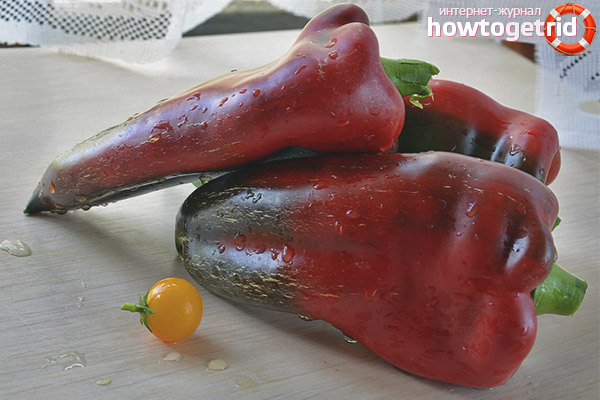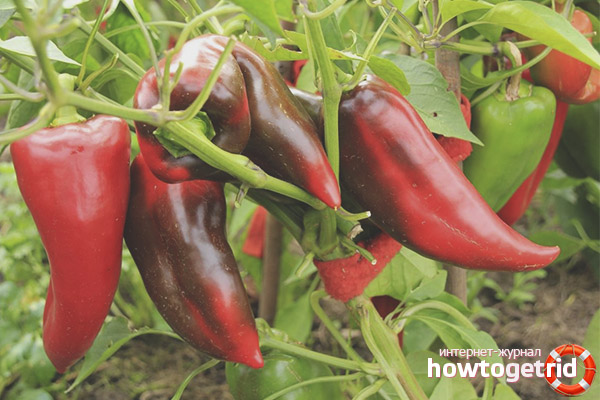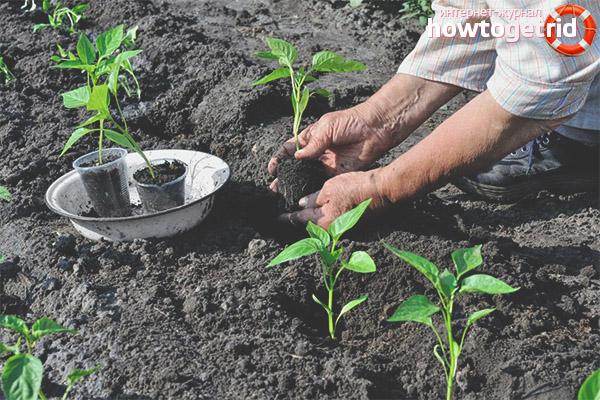The content of the article
Among vegetables, pepper occupies a leading position due to the spicy taste and the presence of nutrients. And even despite the fact that in the process of growth it requires special care measures, it still remains in demand among summer residents and gardeners. Peppers exist today varieties, but there are several of the most popular. These include sweet and delicious peppers called Cow's Ear.
Characteristic features of the variety
The variety belongs to the mid-season category. Technical maturity is achieved after 96 - 100 days, after another 25 days the vegetables already go through the entire ripening cycle and are completely ready for use. You can grow on open ground or in a greenhouse.
The bush itself is small, not more than 70 cm in height, but since it has a very spreading shape, this fact must be taken into account when planting.
The ripened fruit itself is a large elongated cone with sizes ranging from 12 to 16 cm, average weight - about 200 grams. In technical maturity, the ear of the cow has a dark green color, but it changes dramatically in mature form - it becomes saturated red with a smooth glossy surface.
The walls of the vegetable are thick - up to 8 mm, the flesh is fleshy, very juicy, and, importantly, it has no bitterness even when the fruit is not fully ripe.
It has a high stable yield, and the farmer who adheres to all agrotechnical instructions can collect up to 3 kg of vegetables from each square meter.
The presentation of the Cow's Ear and all its taste are perfectly preserved for a long time, if the vegetables are stored in a cool place, not accessible to sunlight. Carries even long transport very well.
Another positive quality is that this variety has strong protective qualities, is resistant to many diseases, and is not affected by the tobacco mosaic virus.
In cooking, this variety is used very actively. There are many recipes where it creates a unique original taste, for example, in lecho. The cow’s ear is also used in salads and many vegetable dishes, appetizers, with which they make homemade preparations and juice.
Growing recommendations
Professionals advise growing this variety through seedlings. And in order to prepare it, they begin to engage in this procedure in advance in March or early April.
This variety grows well in ordinary soil, but for comfortable further growth it is advisable to add a little soil to the container when growing seedlings at home from the place where the bushes will be planted later on. Then young plants will not have to get used to the new conditions, they will sprout together.
In order for the seeds to sprout well, without any problems, a number of important actions are required:
- Only live seeds are needed for growth. To check them, it should be placed in a container of water. Those that immediately rose to the surface have already dried up, and you need to get rid of them.
- The selected seeds must be soaked for several days in settled water at room temperature.
- For further improved growth, it is desirable to treat with a very weak solution of potassium permanganate, then rinse the seeds with water slightly warmed up to room temperature. This method helps the Cow's Ear to acquire the necessary immunity and will provide an opportunity to grow better.
- Prepared seeds are lowered into containers, most often they are convenient peat pots with prepared soil, and covered with a film to create a comfortable microclimate.Usually they ripen amicably, but only if the room temperature is the same, approximately +18 - +20 degrees.
- In each container, it is desirable to plant 2 to 3 seeds, since their germination is usually not so high, and is only slightly above 50 percent. Given this, you need to plant seeds more than the amount that was planned, 2 or even 3 times. And note: it has been observed that sweet pepper varieties are very painful to dive.
As soon as the seedlings sprouted, you need to remove the weak shoots, leaving the strongest.
Transplanting seedlings into the ground
When the sprouts have grown noticeably, they have gained strength, and weather conditions allow, that is, there are no more dangerous night and day frosts, the temperature does not drop below +14 degrees, It’s time to transfer the cow’s ear to the beds. The highest yield of this variety will be in those cases where legumes or cucumbers, siderates or the cruciferous family grew on these beds before it.
Vegetable growers are not advised to use the soil where tomatoes were grown before, but if there is no alternative, it is imperative to add any fertilizer containing organic matter to the soil thoroughly dug in the autumn.
The cow’s ear during growth does not differ in features, grows and requires the same care as other varieties. Since the bush has a spreading shape, during planting, the seedlings should be at least 50 cm apart. The place should be chosen with plenty of heat and light. If the place is darkened, a lot of shade, the bushes grow slowly, become weak, and the fruits will not be so juicy and large. But the temperature is above +30 degrees and the excessively dry air does not like this pepper.
Indoors, during the growth period, it will be necessary to periodically leave the greenhouse on ventilation. If you do not, over time, almost all the ovaries and flowers will crumble.
Watering needs only warm water. The amount of moisture will be needed based on weather conditions, but the usual rate is about twice every 7 days. There is a small feature: until the bushes begin to bloom, it is better to irrigate using the rain method, and then, before harvesting, only under the root system. One bush usually takes 1 - 2 liters of warm water.
It is necessary to feed the cow’s ear; for this, organic and mineral fertilizers must be prepared in advance. Useful for plants bird droppings or slurry, as well as superphosphate.
You do not need to regularly weed and loosen if the beds have been mulled.
With decent quality care, this variety will consistently share the crop until the end of September. Moreover, vegetable growers claim that as soon as one fruit is removed from the bush, the next one is tied on it.
Diseases and pests, the fight against them
A spider mite can attack the Calf’s ear, and in this case a widely used effective folk method is useful: a tincture is prepared using garlic, onions and liquid soap. If the weather is rainy, slug plants may attack. Destroy them immediately, sprinkling bushes with tobacco dust. Effectively sprinkle dry mustard on the land where the ear of the cow grows.
From Colorado gluttonous beetle use infusion made on the basis of celandine.
Video: Cowhide Ear












Submit